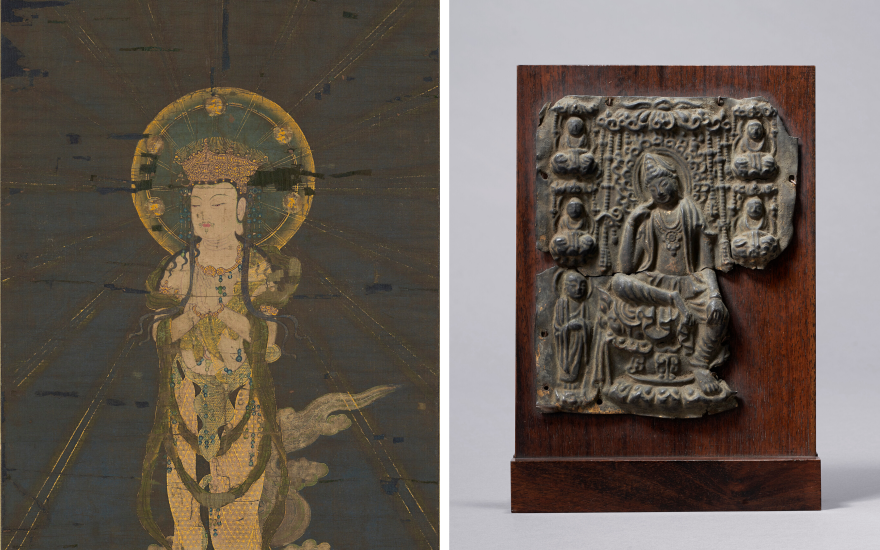[ad_1]
The acceptance of the religion by the imperial court in the 6th century led to a flowering of devotional sculpture and painting that lasted for centuries
By the time Buddhism arrived in Japan it was already a mature belief system, with an almost 1,000-year history. The religion originated in India in around the 5th century BC and spread north across Asia, via the silk routes, to China and Korea. During the late 6th century it was adopted by the Japanese imperial court. Buddhist art was made predominantly for the monasteries and temples that soon appeared across Japan thanks to the patronage of the emperor.
Early Japanese Buddhist art is usually divided into three periods: from the arrival of the faith to the highly refined art of the Heian period (794–1184); the more ascetic Kamakura period (1185–1333), during the reign of the first shoguns; and the Muromachi period (1335–1573).
What forms does it take?
Over the centuries, thousands of statues and sculptures were made for temples and monasteries. Paintings, often executed in ink on silk, were also hung up for ceremonies or rituals, while scrolls with more secular themes began to appear in the later Kamakura period. The main subject, of course, was the Buddha and stories from his life, though images of other deities or guardians were also produced in large numbers.
There is a wide variety of topics and styles, especially in painting, says Julia Meech, the editor of Impressions: The Journal of the Japanese Art Society of America. ‘They range from simple paintings of Buddhist sages in ink on paper, where the interest is in the brushwork, to temple paintings on silk with gold leaf.’
Often, paintings combine elements of calligraphy, such as excerpts from religious texts, with images. In the later Heian and early Kamakura periods chanting the name of the deities depicted was believed to generate a karmic link between the worshipper and the object of devotion.
Who were the artists?
Earlier artists did not sign their work, but by the Kamakura period some sculptors and their workshops can be identified, such as the famous Kei school in Nara — which was briefly the Japanese capital in the eighth century. The sculptors Kaikei (active 1183-1223) and Unkei (c.1150-1233) were its most celebrated pupils.
Several monks signed their paintings. One of them was Gyokuen Bonpo (c.1348-1420), a Zen monk who introduced sparse depictions of plants, often orchids, and nature into his works.
What distinguishes Japanese Buddhist art?
Apart from variations in the figures depicted, different materials were used to create works across Asia, particularly sculpture. While Chinese artists tended to use stone, and Indian and Nepalese craftsmen created works in bronze, Japanese sculptors often favoured carved and painted wood.
During the Heian period wooden sculptures were usually carved out of a single tree trunk, often Japanese cypress (hinoki). By the later Kamakura period they were being assembled from several pieces of wood, a technique called yosegi-zukuri that allowed for more complex compositions as well as greater depth of carving. Wood allowed more subtle lines compared with stone or bronze casting.
Which works are most desirable?
The most sought-after works of early Japanese Buddhist art date from the Heian period, but they are extremely rare and seldom appear on the market. Landscapes painted at this time often represent an idealised vision of the ‘Pure Land of the West’, sometimes showing the descent of Amida, a version of the Buddha who ruled this paradise. The Pure Land strand of the religion took root in Japan, and such paintings remained popular well into the 13th and 14th centuries.
The refined forms of the Heian period were gradually replaced during the Kamakura period by a more sober aesthetic, in response to the emergence of the militaristic shoguns and the warrior samurai caste. This period also saw the emergence of portraiture, especially of monks, which are highly desirable.
The Buddhist monk Myoe (1173-1232) wrote: ‘When you think about an object carved from wood or drawn in a picture as if it were a living being, then it is a living being.’
How to start collecting
Beginners often focus on collecting fragments from early Buddhist sculptures and paintings, or complete compositions from the later Edo period (1615–1867), which are easier to find and more affordable. Most popular are images of hands or flowers, especially the lotus, which is full of symbolic meaning in Buddhism.
Meech says she also ‘highly recommends that collectors look at Edo period Buddhist art, which has been overlooked. The quality is high, and pieces are more likely to be available at auction.’
Be careful of quality
Fakes can be an issue. More recent artists often imitated the work of earlier masters, so it is important to buy from recognised experts who know the difference.
Pieces need to be checked for condition. The incense burned in temples sometimes damaged the surface of paintings, while inks made from vegetable dyes fade over time.
Why collect?
The high artistic quality of early Japanese Buddhist art has wide appeal, even for those without an in-depth knowledge of the subject. It appeals to many people because of the subtlety of its forms and the mastery with which figures and nature are depicted.
Meech says: ‘In Japan, the patina, colour and texture of the wooden sculptures, as well as the delicacy of carving, make them particularly desirable. For Western buyers, Japanese art also tends to be more easily available than works from China — there are fewer issues with export permits, for example.’
Where can I learn more?
The easiest way to see early Buddhist Japanese art is to visit the country. There are extensive collections in Tokyo and Nara, and many examples in ancient temples.
In the West, there are excellent collections in the Museum of Fine Arts, Boston, the Metropolitan Museum of Art in New York, the Musée Guimet in Paris and the British Museum in London.
Some recommended further reading on the topic includes Gilles Béguin’s Buddhist Art: an Historical and Cultural Journey (River Books, 2009) as well as the following exhibition catalogues: The Collection of David and Nayda Utterberg (2022); Kamakura: Realism and Spirituality in the Sculpture of Japan (Asia Society New York, 2016); and Awakenings: Zen Figure Painting in Medieval Japan (Japan Society New York, 2007).
[ad_2]
Source link















